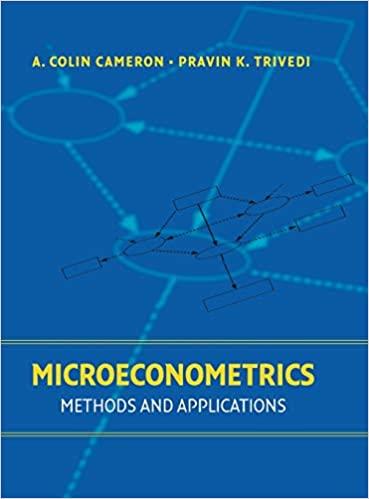Continue with the gamma model of Exercise 5-2. (a) Show that (partial Q_{N}(boldsymbol{beta}) / partial boldsymbol{beta}=boldsymbol{N}^{-1} sum_{i}
Question:
Continue with the gamma model of Exercise 5-2.
(a) Show that \(\partial Q_{N}(\boldsymbol{\beta}) / \partial \boldsymbol{\beta}=\boldsymbol{N}^{-1} \sum_{i} 2\left[\left(y_{i}-\exp \left(\mathbf{x}_{i}^{\prime} \boldsymbol{\beta}\right)\right) / \exp \left(\mathbf{x}_{i}^{\prime} \boldsymbol{\beta}\right)\right] \mathbf{x}_{i}\).
(b) What essential condition indicated by the first-order conditions needs to be satisfied for \(\widehat{\beta}\) to be consistent?
(c) Apply a central limit theorem to obtain the limit distribution of \(\sqrt{N} \partial Q_{N} /\left.\partial \boldsymbol{\beta}\right|_{\beta_{0}}\). Here you can assume that the assumptions necessary for a CLT are satisfied.
(d) State what CLT you would use to verify part (c) and what additional information, if any, is needed to apply this law. A brief answer will do. There is no need for a formal proof.
(e) Obtain the probability limit of \(\partial^{2} Q_{N} /\left.\partial \boldsymbol{\beta} \partial \boldsymbol{\beta}^{\prime}\right|_{\beta_{0}}\).
(f) Combine the previous results to obtain the limit distribution of \(\sqrt{N}\left(\widehat{\boldsymbol{\beta}}-\boldsymbol{\beta}_{0}\right)\).
(g) Given part (f), state how to test \(H_{0}: \beta_{0 j} \geq \beta_{j}^{*}\) against \(H_{a}: \beta_{0 j}<\beta_{j}^{*}\) at level 0.05 , where \(\beta_{j}\) is the \(j\) th component of \(\beta\).
Exercise 5-2
Consider the following special one-parameter case of the gamma distribution, \(f(y)=\left(y / \lambda^{2}\right) \exp (-y / \lambda), y>0, \lambda>0\). For this distribution it can be shown that \(\mathrm{E}[y]=2 \lambda\) and \(\mathrm{V}[y]=2 \lambda^{2}\). Here we introduce regressors and suppose that in the true model the parameter \(\lambda\) depends on regressors according to \(\lambda_{i}=\exp \left(\mathbf{x}_{i}^{\prime} \boldsymbol{\beta}\right) / 2\). Thus \(\mathrm{E}\left[y_{i} \mid \mathbf{x}_{i}\right]=\exp \left(\mathbf{x}_{i}^{\prime} \boldsymbol{\beta}\right)\) and \(\mathrm{V}\left[y_{i} \mid \mathbf{x}_{i}\right]=\left[\exp \left(\mathbf{x}_{i}^{\prime} \boldsymbol{\beta}\right)\right]^{2} / 2\). Assume the data are independent over \(i\) and \(\mathbf{x}_{i}\) is nonstochastic and \(\boldsymbol{\beta}=\boldsymbol{\beta}_{0}\) in the dgp.
Step by Step Answer:

Microeconometrics Methods And Applications
ISBN: 9780521848053
1st Edition
Authors: A.Colin Cameron, Pravin K. Trivedi





